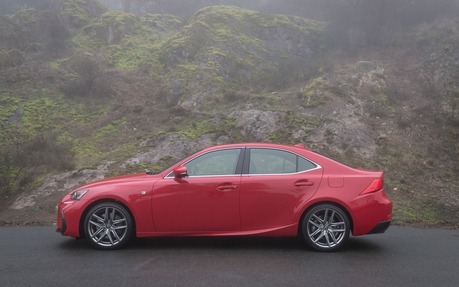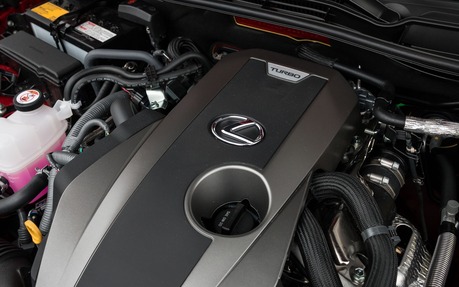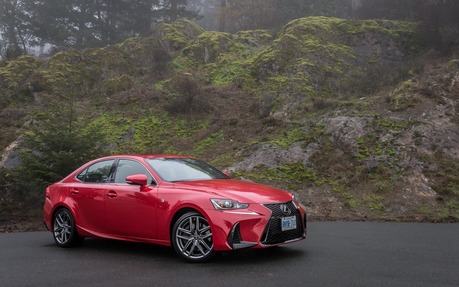2017 Lexus IS: Road Yes, Track No
Given that the luxury compact sedan segment is more popular than ever, there’s no room for error. All players have to be up to par, lest they drag the whole class down with them. And gone are the good old days when the E-Class ruled the roost. Sure, the E-Class continues to enjoy impressive popularity around the world, but in Canada, the C-Class is top dog.
And the C-Class’ dominance isn’t limited to sales. Quality-wise, Mercedes-Benz offers a nearly perfect car, one that excels at every level. Disarray reigns at Acura and Infiniti’s product is panned by critics. But at Lexus, the IS is looking pretty smug.
- Also: 2016 Lexus IS 200t: Slowing Down
- Also: Infiniti Q50 Vs. Lexus IS 350: The Devil Is In the Details
Lexus is the Japanese brand that comes closest to the German automakers. In fact, the IS holds its own incredibly well in everyday situations. The same can’t be said for the drivetrains—but we'll come back to that.
Why “launch” the 2017?
Good question. The 2017 IS represents a mid-cycle refresh for the current generation. At first glance, however, there doesn’t seem to be much difference. But if you take the time to compare a 2016 version with the 2017, you’ll immediately notice that the front has been redesigned, as have certain aspects of the tail end. These changes aim to make the car even more aggressive, in spite of a design that many already called overtly streetwise when it first launched.

Inside, there aren’t many changes to the cabin layout to report, except that a large 10-inch horizontal screen is now available in some trims. There are also new seats made using a unique technique that essentially involves filling a leather envelope with memory foam. These seats are nice looking, super comfortable and the faux leather used in the basic versions is pretty convincing. That said, the sport seats available in the F SPORT package end up being a bit narrow because of oversized side bolstering, which some people may not like.
As for things you can’t see, supposedly the suspension and chassis calibrations were updated to provide sportier handling.
The drivetrains remain the same. The base version, the IS 200t, is a rear-wheel drive only and has a four-cylinder turbo that generates 241 horsepower and 258 lb.-ft. of torque. This mill is mated to an eight-speed automatic gearbox. The IS 300 comes with all-wheel drive only and leverages a 255-horsepower, 3.5-litre V6 paired with a six-speed gearbox. Meanwhile, the IS 350 also sticks to AWD exclusively and uses the same engine—albeit with 306 horsepower—and the same automatic gearbox.
Those of you who like to believe that there’s always a computer looking out for your safety will be happy to hear that all versions of the 2017 Lexus IS, even the most basic, are equipped with Lexus Safety Sense, a system that includes pedestrian detection, automatic emergency braking, adaptive cruise control and more.
Not a track beast
Lexus is the most reliable brand on the market and the IS is one of its most reliable vehicles. Thus, the Lexus IS is perfect for people who would rather be driving their car than hanging out at an Audi dealership while waiting for their cappuccino to be ready.
On normal roads, all versions of the IS offer the comfort of a luxury car and the sporty touch that you’d expect in this class. However, Lexus has confidence in its product and, during the launch of the 2017 IS, we spent half our time on a very technical circuit on Vancouver Island.
Where to begin? How about with the IS 200t... As it only comes with rear-wheel drive, you’d expect its handling to be fun and its steering to be conducive to easy cornering. There is none of that. With too many electronic systems and imprecise steering, you constantly feel like you’re fighting with the car.

Moreover, the four-cylinder turbo engine lacks punch, especially when compared to the equivalent Mercedes-Benz engine. The eight-speed gearbox shifts gears without the driver’s consent, even in manual mode, meaning that we found ourselves in fourth gear when we should have been in second. So, when exiting turns, you have to wait for it to shift back into second. Thea gear change is followed by a lengthy complaint from a winded engine.
The IS 300 AWD likes the track slightly more, but again, power is lacking. Its 255 horsepower is insufficient to compensate for the additional weight of the front-end drivetrain, compared to the RWD IS 200t, but the six-speed automatic gearbox performs better than the eight-speed gearbox—especially in manual mode!
We expected the IS 350 AWD to save the day, and it did, but barely. The 306 horsepower squeezed from the V6 were a welcome tonic, especially exiting turns. And hats off to the all-wheel drive system that let us accelerate aggressively even on corners. However, sport version or not, the lack of feedback from the steering doesn’t inspire confidence and, strangely, you can’t read the car to know if it is nearing its limits in turns. Once again, the six-speed gearbox isn’t too bad, but it seems ancient compared to the developments at Audi, BMW and Mercedes-Benz.
Improved chassis? Sure, we noticed the additional rigidity, but it doesn’t make the 2017 Lexus IS a particularly sporty car.
That’s essentially all you need to know about the 2017 IS. On the road, it’s comfortable, carefree and refined. On the track, it’s out of its element. When it comes time to kick things up a notch, you see how German engineering remains superior in this segment. But hey, why even bother talking track performance when almost all buyers in this category won’t ever drive their luxury compact on a track? That’s exactly why the 2017 IS remains relevant. If you’re thinking of buying this model, go for it. You’ll be happy you did.
| Test drive report | |
| Test model | 2017 Lexus IS |
|---|---|
| Trim level | N/A |
| Price range | N/A |
| Price as tested | N/A |
| Warranty (basic) | N/A |
| Warranty (powertrain) | N/A |
| Fuel economy (city/highway/observed) | N/A |
| Options | N/A |
| Competitive models | Acura TLX, Audi A4, BMW 3 Series, Buick Regal, Cadillac ATS, Infiniti Q50, Jaguar XE, Lincoln MKZ, Mercedes-Benz C-Class, Volvo S60 |
| Strong points |
|
| Weak points |
|
| Editor's rating | |
| Fuel economy | Average for its category; nothing special. |
| Comfort | Comfortable handling in spite of a sport suspension. |
| Performance | The IS 350 is adequate, but the IS 200t and IS 300 are disappointing. |
| Infotainment | Overly complex, the graphic interface leaves something to be desired. |
| Driving | Although it has trouble on the track, it’s pleasant on the road. |
| Overall | The Lexus IS will never be a bad choice, but it isn’t on par with the German cars. |
